
This past weekend Team Arctic Cat/Christian Brother Racing pro Ryan Simons of Camrose, Alberta, won the USXC Seven Clans Casino I-500. It was an emphatic win for the 30-year-old Simons, who had already notched four victories in USXC races this season, and was the USCC high-point champion the previous two seasons.
Ryan took some time off from getting his sled ready for the race this coming weekend to answer some questions about the big win and other topics.
AI: First of all, congratulations Ryan, that was an outstanding race. Describe what it feels like to win the I-500.
Simons: Thanks! It’s something I’ve had on my back since I started competing in this race… and it’s only the second time I’ve finished. The I-500 is for cross-country what the X Games is for snocross, where I go in hoping for a top finish. It feels so good to finally get it done.
But now the pressure is on and I’m already thinking about next year. It would be tough to repeat, not that many people have done it because there are so many variables.
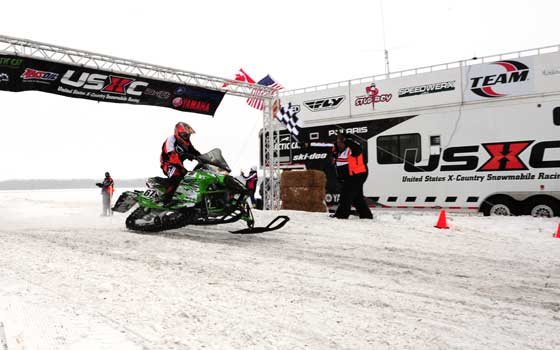
AI: When did it sink in that you’d won the I-500, and how did you and the team celebrate?
Simons: It sunk in once I crossed the finish line. Even though I had a big lead, I wasn’t taking anything for granted.
Celebration? We went to the USXC banquet and hung out with everyone there. After that we went to Fertile, Minn. (where the Christian Brothers Team is headquartered) and hung out for a bit, but I was in bed by Midnight. There was no huge party or anything. We’d all been awake since 5am, plus the days of typical stress that this race brings, so by the time we got back to Fertile everyone was ready to sleep.
AI: You’ve been in other I-500s when you were considered a strong favorite going in. What was the difference this time?
Simons: No one has won this race without a little bit of luck on their side. The previous years’ I’d had a couple mechanicals that took me out, never crashed out. We all learned from those experiences. I finished second (to teammate Brian Dick) in 2011, the last year they had the race. Experience counts for a lot in this race. It’s a race you have to run a few times to figure out.

AI: Give me a rundown of how each day went, any problems or challenges you had along the way.
Simons: The first day I was the 15th starter. My goal was to get as far up front as possible, so I rode at 100% whole time. I made some serious time, but I also had a huge crash. I’d just passed Aaron Christensen and was trying to put a gap on him. There was a ditch approach with double-down arrows (which indicates danger and that you should slow down –Ed.) but I just kept it pinned. I ended up hitting the corner of a fence post and rolled. I was going fast and ended up a good 100 feet from sled. The sled endo’d end-over-end at least once, but it eventually landed upright and was okay. I was fine and pretty much just got lucky. I had to chase back Aaron again, but I still caught him before the first fuel stop. In hindsight, I took a risk I shouldn’t have taken.
I still pinned the rest of the first day and ended up being the first guy to finish. I had a lead of almost 3 minutes over second place. My sled was running low on RPM that day, which was a bit of a concern for the team, especially with my teammates Brian Dick and Zach Herfindahl out of the race due to mechanicals.
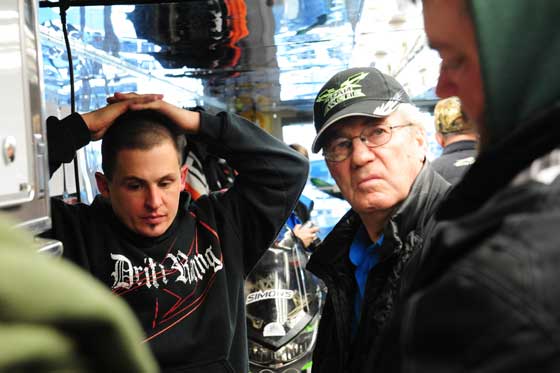
Day two was sunny like the first day and just plain fun. We’d had a long meeting after the first day and knew that I just needed to just finish and not try to go 100% on the second day, so that’s what I did. Nothing crazy happened…no pucker situations because I didn’t take any big chances. And the changes we made to the sled after the first day were awesome, so everything worked well. By day’s end I had a nearly 10-min. lead over second place, so it worked out better than we expected.
Day three was a mental day more than a physical one. I had to stay focused on what I was doing and try not to make mistakes. It was overcast with a light mist, so it was hard to see any definition of bumps or other stuff along the course. That kind of flat light is hard to run in, but it’s the same for everybody. There were areas where there weren’t tracks, which is hard to go for the first guy. I rode a pace like day two, not taking any chances. I treated it like a fast trail ride. After first fuel stop I knew Aaron (Christensen) had taken 45 seconds out of my lead, so I picked it up just a bit for the second of three loops that day. When I came back into the fuel stop for the second time, as well as a couple other pitboard notices after that, I got info that I’d extended the lead to close to 12 minutes. So for the last 40 miles or so I took it pretty easy.

AI: Okay so you backed off off the second and third days. Put a percentage on that pace compared to your 100% pace on day one.
Simons: Hmm… maybe 85% or so. It’s hard to say. Sometimes slower is faster. I made no mistakes the last two days. Going 100% and not making mistakes is the fastest, but it’s hard to do that. You make mistakes when you ride at 100%, like I did with the crash. Having a clean race on day two is a huge reason why I won.
AI: What’s the craziest moment that happened during the three days?
Simons: The crash on day one, definitely. I had a crash last year at Grafton, ND, that was way worse, in which I was going 102 mph hit a big rock that just stopped me. Well, not stopped, but it sent me rolling. I shouldn’t have walked away from that one.
Those crashes are bit of a reality check but they don’t change the way I race. I still go as hard as I need to. I don’t feel like I ride out of my ability level, I feel pretty comfortable.
If I can see the shape of the launch, then I don’t think about it. In the air is kind of my rest time. Being able to ride like that comes down to having time on the sled to know how it’s going to react.
AI: Compare your current 2013 Arctic Cat Sno Pro 600 XC with last year’s Sno Pro.
Simons: The sled we have this year is amazing. I really wish I was younger and could race it in snocross, because it does everything so well. It’s probably my favorite sled in whole career, as good as the 2007 Sno Pro which I really liked too.
Compared to last year’s sled, we’ve made a lot of little improvements. It’s faster and handles better. Raising the driveshaft location was a big improvement. In the ditch, this sled is incredible.
Lake racing is still a bit weird for me, probably because I’m short so I can’t hang off as well. I’m getting better and faster at it, but I’m not yet comfortable with it. I like running the ditch a lot better.
AI: How does this win rank with the two USCC championships you’ve won the past two years?
Simons: That’s a good question. Winning championships is a big deal, but winning the I-500 is probably better than winning the championships. It’s a hard race to win. Stuff has to go your way… the sled has to be good… the crew has to be good and you need some luck. But I suppose the same is true for Championships.
AI: Do you practice and/or test for this kind of riding and, if so, describe how you approach that (frequency, distance, pace, etc…)?
Simons: No, we haven’t had enough snow for practicing until this last week. Normally I would ride some during the week, mainly testing. This season and others we get to the track the day before the race for riding and testing.
If I rode every day during the week we’d need some more equipment (laughs). Seriously, to really practice for true ditch racing you have to ride at race pace and on race sleds. I would do too much damage to my sleds and my body.
I help work on the sleds during the week. My mechanics Hector Olson and Corey Berberich and I get to the shop at 8am and work until 5pm every day. In fact, the I-500 sled was already stripped down completely on Monday. We’ll put it back together for the USXC race in Hoyt Lakes this weekend. It’s one of two race sleds I have this year… it’s my favorite of the two even though they’re both set up exactly the same. This (I-500 sled) is the one I started the season with and I really like it. The other sled I used at Oslo a couple weeks back, but I haven’t felt the same on it.
It’s weird, but it’s almost impossible to make two sleds feel identical. Each one has its own personality. What makes it that way, I don’t know. But it’s real.
AI: You’ve been full-time cross-country since you switch from snocross beginning with the 2011 season. Describe what you like about each form of racing, and if you think other snocrosser would do well and enjoy cross-country?
Simons: I like both a lot. I loved the competitiveness of both and the people associated with both. The hardest part about leaving snocross was leaving all the people who had been such a big part of my life for 10 years.
Physically, snocross is a whole different sport. The training required and the shape you need to be in… that’s a different level than cross-country. You have to train non-stop just to stay in shape for snocross. It’s hard to dedicate that much of your life to something. I was one of the oldest guys still racing Pro when I switched to cross-country. I needed a change.
Cross-country has been a great fit. We just decided to try it and we fell in love with it. You still have to be in shape, but it’s not as intense as snocross. I really enjoy the racing part of cross-country. In fact, that’s the easy part… it’s getting to the track that’s the hard part: the work, preparation and such.
AI: How did you first get involved with the Team Arctic Race Program?
Simons: My family has always ridden Cat. The first race sled that I competed on was a 1999 ZR 440, which I raced in the Camrose area. During the 2002 season, some friends brought me down to a race at the Fargo dome. I raced Semi Pro and won.
Brian Sturgeon (who was then the Team Arctic Race Manager) approached me after that and it snowballed after that.

AI: Tell me about the role the Christian Brothers Racing team plays in your success?
Simons: They are pretty much everything as far as making it possible. Well, them and Arctic Cat. They are amazing sponsors and a huge part of what I do. My crew is amazing and there’s no way I could do this without them. Hector and are my crew. Hector is motor, clutching guy, while Corey gets everything else done.
Beyond the support, they’re also some of the greatest people in the world. They take care of me and all the racers exceptionally well. We have three houses in Fertile, Minn., that we live in. Garth Kaufman and his family are in one. Logan Christian and I live in another, but he’s gone all the time so it’s pretty much just me. The other house is where is Justin Halvorson, Ethan Hanson and Hector live.
In addition to Arctic Cat and Christian Brothers, I have other awesome sponsors, including: DRIFT, Speedwerx, FOX SHOX , Troy Lee Designs, Scott, Stud Boy and SleckNecks.
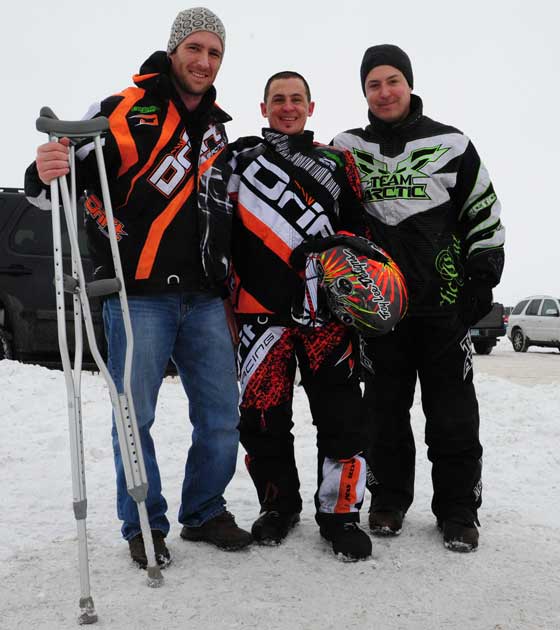
L-to-R: Christian Brother Racing teammates D.J. Ekre (still recovering from pelvis injury), Simons and Brian Dick.
AI: Is there any competitive fire that happens between you and your teammates D.J. Ekre, Brian Dick and/or Zach Herfindahl?
Simons: We all get along great. Zach’s new and he’s great. He’s already super fast and he’s only going to get better. The other guys… Brian and D.J…. we get along great. I wouldn’t be where I’m at now if I couldn’t have learned from those two. They taught me so much about how to race XC. We collaborate with testing, set up and strategy, but on the track I race them the same as I would anyone else.
AI: Okay, a purely hypothetical scenario (laughs). You’re leading the I-500 after the first two days by a single minute. Who’s the last guy you want to be in second, one minute back on the final day?
Simons: There are a number of guys who are crazy fast, but I’d say D.J. Ekre. Because in a situation like that you have nothing to lose. And when D.J. is like that, he can go so fast it’s scary.
AI: Okay back to reality… you’ve won five USXC races (three Pro 600 and two Pro Open) so far this season and now you’re leading the Championship points race in both. What’s your approach to the remaining three events… back it off like it’s the second and third legs of the I-500 in order to preserve your points lead, or go for it like you did the first ditch approach on the first day?
Simons: It will be like the first day (laughs). I’m assuming the next three races will be rough, so that benefits me. Every time I go to the track, I’m thinking about winning that day, not about the Championship. Afterwards it’s great to lead or win a Championship, but going into each race I simply want to win.
AI: Is racing your full-time job?
Simons: It’s a full time occupation in the winter, but I couldn’t live off of it. Time-wise it’s full time, but money-wise it’s not.
I own a small trucking company back home that hauls equipment to support the Canadian oil fields. Its part of a family business and I work full-bore on it in the Spring and Summer. I’m lucky my dad steps in and runs my end of the business during the winter, which makes it possible for me to race.
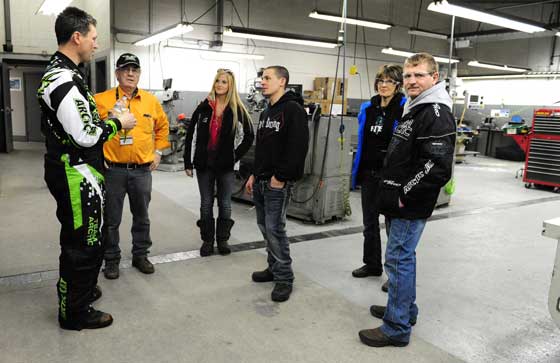
Ryan Simons and family get a tour of the Arctic Cat factory from Roger Skime (yellow shirt), where they chat with engineer Troy Halvorson (left).
AI: Okay, final request. Tell me a good Roger Skime story.
Simons: Laughs… What more can be said about the guy? He’s just awesome and he’s the most die-hard racer I know. I consider him one of my best friends.
Here’s something that’s cool and recent: My parents and girlfriend came down from Camrose to watch the I-500 this year. After the first day was over and the maintenance session was complete, we still had a lot of time to hang out. So we went into town because I wanted to show them the Arctic Cat factory. We didn’t have any plan or anything line up, we just showed up. I called up Roger, who immediately came to the lobby, grabbed us and gave us his personal tour of the whole place. We went through Engineering, checking out all the new stuff. It was awesome!


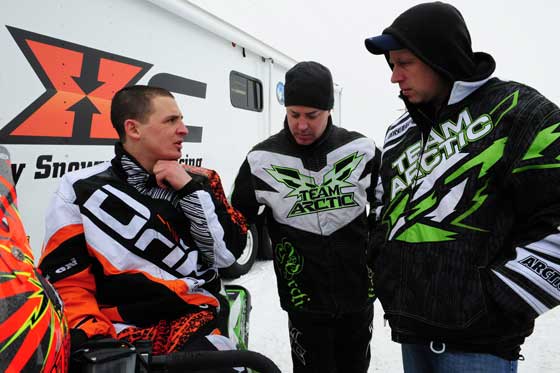
Great Interview.
Great Win for Ryan and Cat.
Congratulations Ryan.
Alan K
Wish I could have watched. Best racing ever was watching Ryan and DJ battle in the ditches at the i500. Great job Ryan. You definitely have a different percentage rating of your riding than most.You Don’t run out of talent to often.